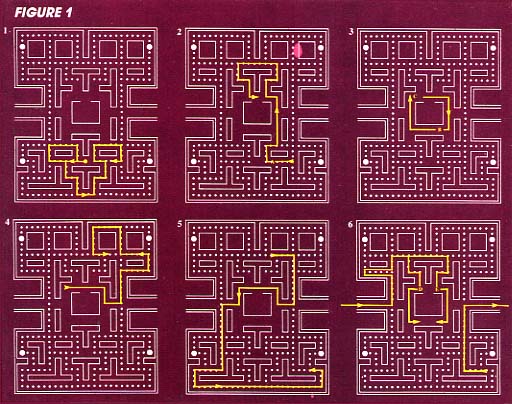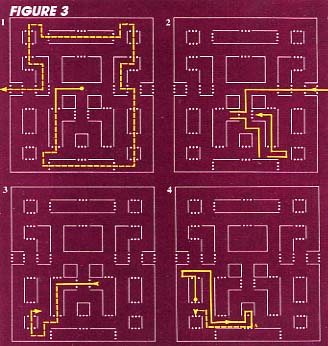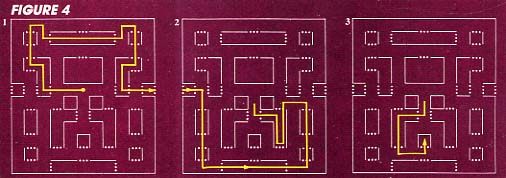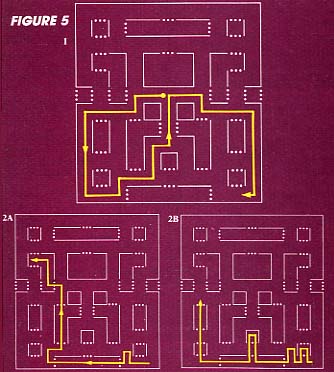
|
MASTERING PAC-MAN PLUS AND SUPER PAC-MAN
BY KEN USTON
|
Hundreds of players racked up enormous Pac-Man scores, well into the millions, using pre-determined patterns of movement through the maze. Some patterns enabled players to continue almost indefinitely.
In early 1982, the first Pac-Man spin-off appeared on the scene, a distaff version of the monster maze game, called Ms. Pac-Man. Patterns didn't work for Ms. Pac-Man because, unlike the Pac-Man monsters, the new pursuers did not move in totally predictable patterns through the maze. (I have seen some patterns that lead to high Ms Pac-Man scores, but they don't work with the consistency of the Pac-Man patterns.)
Ms. Pac-Man soon dominated arcade action. Bally, mindful of the Pac-Pot of gold behind the well-known smiling yellow video megastar, soon came out with two more versions which have been popping up in arcades across the country over the last several months. It's good news once again for methodical, cerebral-type players, because both of these renditions, in varying degrees, can be mastered by using patterns.
PAC-MAN PLUS
One of the new games, Pac-Man Plus, has a secure place in the annals of the arcade history because it is the first widely-used legal "speed-up chip." " (In 1982, third party manufacturers began producing revised chips for some of the coin-ops to make it more difficult for players to score millions of points and tie up the machines for hours on end. The coin-op manufacturers went to court and succeeded in getting a ruling making these illegal.) The Pac-Man Plus chip, which fits into the regular Pac-Man cabinet, is legal because it is manufactured by Bally, the makers of the original game.

|
Pac-Man Plus (I'll refer to it as "P+" from now on) has the same board layout as conventional Pac-Man (shown in Figure 1). But there are key differences from the original game:
1. The monsters revert to their vulnerable state if the player "eats" either an energizer or a symbol (only the energizer causes this transition in Pac-Man).
2. Points awarded for eating monsters after eating a symbol (not an energizer) are twice as high as in the conventional game (400, 800, 1600, and 3200 points, respectively).
3. When the monsters are in their vulnerable state, they occasionally become invisible, and one monster occasionally remains in his normal, dangerous predatory condition.
I have developed a pattern that should allow the average player to score about 100,000 points on P+. The pattern is fairly easy to learn and is the only one that must be memorized for the first ten boards or so. (In conventional Pac-Man, the 100,000+ scorer must memorize several patterns.)

|
As is the case with Pac-Man, there are two types of Pac-Man Plus games, a fast game and a slow game. This pattern works for fast game boards. In the slow game, the first several boards are quite easy to clear improvisationally; the pattern can be used to clear the advanced boards.
The Pac-Man Plus boards are arranged as shown in Table 1.
The pattern in Figure 1 works consistently up through the first Galaxian board and sometimes a board or two beyond that, depending upon the player's timing. Most players will have a six-figure score by that time. Scores will vary because points per board completed fluctuate even more in P+ due to the larger monster-eating bonuses.
For Charts 1 and 2, just follow the path as depicted. When you approach point A in Chart 2, you may be tempted to move away from the light blue monster. Don't. Adhere to the pattern; you'll be safe.
On Charts 3 and 4, hesitate and make a brief reverse at point B. Then continue clockwise, eating the symbol; when you get to point C, you will start eating the invisible monsters. You will often be able to eat all four monsters as you continue along the path shown in Chart 4. If you do, you will rack up 6000 bonus points (400 + 800 + 1600 + 3200).
For Charts 5 and 6, follow the patterns. When you get to the northwest corner in Chart 6, eat some dots (you don't have to eat the energizer at this point) and then get the symbol a second time. Your path into the center may be either path D or path E, depending upon the danger posed by the monsters.
After Chart 6, merely clear the energizers, without worrying about chasing monsters. At this point, there are two key points to remember:

|
With a little practice, this pattern should get you up to 100,000 points. Beyond the tenth board or so, improvisation is necessary. The final pancake symbol is the equivalent of the well-known Pac-Man blue key: it is the final symbol, it is worth 5000 points, and it continues to appear indefinitely. If you get through the first pancake board, your score should be around 150,000.
|
||||||
SUPER PAC-MAN
Unlike Pac-Man Plus, Super Pac-Man is a totally new game, with a different concept which has a significant effect on the good player's strategy.
In Super Pac-Man, there are 30 symbols and two types of energizers scattered around the maze, located inside of partial partitions (see Figure 2). These must all be eaten before you complete the board. Throughout the Super Pac-Man (SP) board are little gates, each of which can be opened by hitting an appropriate blue key. There are 15 such gates, each with a corresponding blue key.
An important new feature in SP is that Pac-Man may become totally indestructible--hence the title of the game. Even kryptonite cannot adversely affect our friend, who becomes enormous and can run safely through gates, monsters, and keys.

|
SP is a unique Pac-Man rendition in that it has two controls, rather than one. In addition to the conventional four-way joystick, the player controls a button which makes Super Pac-Man travel as fast as a speeding bullet. Thus he can cover more territory while in his "super state," allowing the player to amass more points.
Two super energizers convert Pac-Man into Super Pac-Man. A bonus star also appears periodically; the player gets additional points for hitting it.
After several boards are completed, the player is awarded a bonus stage (similar to the challenge stages of Galaga) in which he cannot lose his man. If the player is able to clear the entire board during the bonus stage, he is awarded a large point bonanza. This is where the pattern player will be able to excel, because, as we will see, there is a single pattern that can be used to consistently clear the bonus stage boards.

|
Super Pac-Man boards occur in the sequence shown in Table 2.
Figure 3 shows the pattern that will complete the first two boards, the Apple and Banana. As in Pac-Man and Pac-Man Plus, there are both fast and slow games.
The Figure 5 pattern applies to the initial fast game boards and later slow game boards; the earlier boards of the slow game are completed rather easily through improvisational play.
The button should be pushed at all times when Super Pac-Man appears. In Charts 3 and 4, after hitting the south-west energizer, immediately push the button and eat as many monsters as possible at point A, before finishing the board.
The bonus stages offer large bonuses if all symbols and energizers are eaten before time runs out. Figure 4 shows the pattern that will enable you to do this. Again, the button should be held down throughout. Happily, this pattern works for all bonus stages, even the advanced ones. It will take a few practice games to be able to negotiate some of the subtle movements at the super speed.
I have not yet discovered a single pattern that will work universally for the subsequent non-bonus boards. However, a good rule-of-thumb to remember is: eat the keys in the lower quadrant first (as shown in Figure 5). This will open all the lower gates. The path depicted in Figure 5 will generally work. After Chart 1, the bottom nine keys can be cleared by following the path on either Chart 2A or 2B. This varies from board-to-board.
As in Pac-Man and Pac-Man Plus, the key to this game is to progress through as many boards as possible without risking destruction by trying to eat extra monsters. This is because most point values increase with each subsequent board. As importantly, you will have the opportunity to play more bonus stages, which you should be able to complete time and again with the pattern in Figure 4.
|
||||||